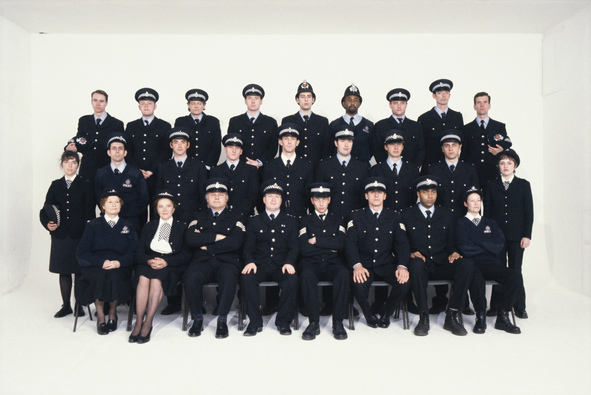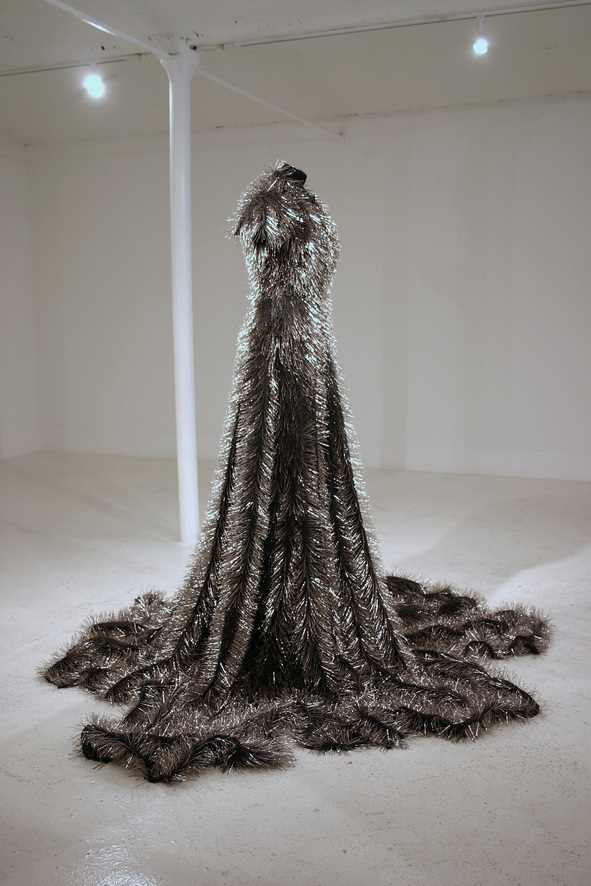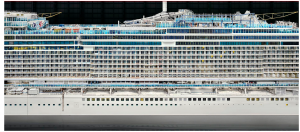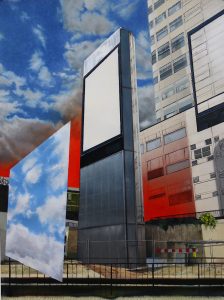
Image:Gillian Wearing Sixty Minute Silence 1996 Colour video projection with sound, 60 minutes Courtesy Maureen Paley, London
2 December 2010 – 30 January 2011
It was a snowy morning for the press view of the third GSK Contemporary exhibition at the Royal Academy, and the white muffled silence outside assisted silent contemplation of the works on show.
I must admit, the title led me to some preconceptions that this might be a rather beautiful yet rather shallow collection of items created apropros of nothing, but what I found astounded me. Broken into four areas: Storytelling, Building, Belonging & Confronting, and Performing, the show leads you through a journey of self-discovery and inspection, and deconstructs the fabric of our lives (in many cases literally).

Image:Grayson Perry Artist’s Robe 2004 Embroidered silk brocade, leather, printed linen and ceramic buttons © Grayson Perry
Courtesy the artist and Victoria Miro Gallery, London
The show is multilayered – recurrent themes run through the four areas, and one such thread is individuality, which begins the exhibition with Grayson Perry’s Artist’s Robe. A sumptuous creation harking back to Japanese and Buddhist scholars, it is worn as an indicator, a tribal sense of belonging; a kind of uniform. Adorned with eyes, a traditional symbol of knowledge and the artist’s interaction with the visual world. Curator Kathleen Soriano explained that this startled her after countless meetings with artists arriving in paint-splattered denim. Uniforms appear later, in Gillian Wearing’s Sixty Minute Silence, in which a group of people in police uniform sit still for an hour – their individual fidgets under observation undermining the power of the collective. Work at the end of the show by Andreas Gursky, Kuwait Stock Exchange, also explores the uniform vs the individual, as workers in traditional Arabic ghutra headdress are photographed from a distance so that they become indistinguishable from one another.

Image:Susie MacMurray Widow 2009 Black nappa leather, 2 inch adamantine dressmaker’s pins Manchester City Galleries (Gallery of Costume) Photo Susie MacMurray
The snow and the show share a second characteristic, a stinging seduction, the guise of fashion masking many more chilling tales of how the works came to be and what they represent. The most seductive example of this is Susie MacMurray’s Widow, a dress made of 100,000 adamantine needles and leather. From a distance the sparkling folds are dazzling, but a closer look unveils the violent nature of the pins, symbolising the toil of female craft but also MacMurray’s self-punishment (she pierced each pin through the leather herself by hand) in grief at the death of her husband.
A personal favourite and one which seduces then shocks is Sharif Waked’s video installation Chic Point, 2003. A catwalk showcases garments which appear almost mundane (blue, white and black shirts) until we notice an area of exposed flesh, for example an extra collar at the stomach or a hole cut in the back. Lulled into a sense of the absurd and the glamour of the fashion show, we are then shown the inspiration for these faux designs; press photography of the daily humiliation of inspections at checkpoints in Palestine. Waked’s fashion attempts to add a degree of dignity to this ordeal and pits the individual against the state.
Interaction between the individual and the world surrounding them can be seen in Katerina Šedá’s work For Every Dog a Different Master, where Šedá’s despair at residents on her housing estate never communicating with each other led her to print 1000 shirts with an image of their buildings, which she then sent to residents in the newer part with the contact details of a ‘sender’ in the old part. This aptly demonstrates the struggle not to be swallowed into a world of anonymity.
The overall impression of the show is one of struggle. Despite the seduction and glitzy connotations of the words ‘fashion’ and ‘art’ in the title, GSK Contemporary is all about hidden undercurrents; revealing the painstaking process of making something beautiful (work by Yinke Shonibare MBE was commissioned specifically for the show in collaboration with London College of Fashion and he worked with bespoke tailor Chris Stevens to produce 18 Victorian children’s dresses, each created with only three different Dutch batik fabrics), but also using beautiful items to illustrate the struggle of the individual to make sense of the world around them, to carve some sort of identity in a world categorised, documented and divided. There are juxtapositions here: the sting running under the seductive outer layer like the dark creatures encircling Hussain Chalayan’s floating white dress, the individual fighting to escape the collective, and the story revealed to acknowledge the role of clothing in the representation of a cultural history. Curators Kathleen Soriano, Gabi Scardi and Lucy Orta have brought this together immaculately to ask us to question our own identity, and ultimately to become Aware.
Not to be missed.
www.royalacademy.org.uk/







